Even the best of intentions can fall flat without full attention to vital details. The Korea Herald looks into flaws and shortcomings of Korea’s green policies. – Ed.
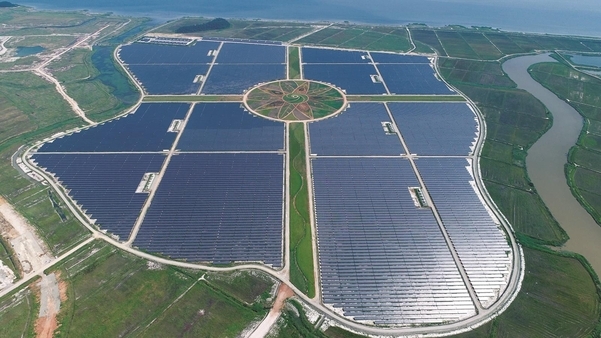 |
Korea’s biggest solar power plant in Haenam, South Jeolla Province, made using Chinese solar cells (Hanyang) |
The definition of a government subsidy is simple: public funds granted to a domestic industry to maintain price competitiveness.
However, the South Korean government’s renewable energy subsidy program launched in 2012 is doing just the opposite.
Last month, the country’s largest solar power plant was completed in Haenam, South Jeolla Province, that can generate electricity for 27,000 households per year.
But the plant triggered a national debate on whether it deserves state subsidies as it has been built entirely with Chinese solar cells.
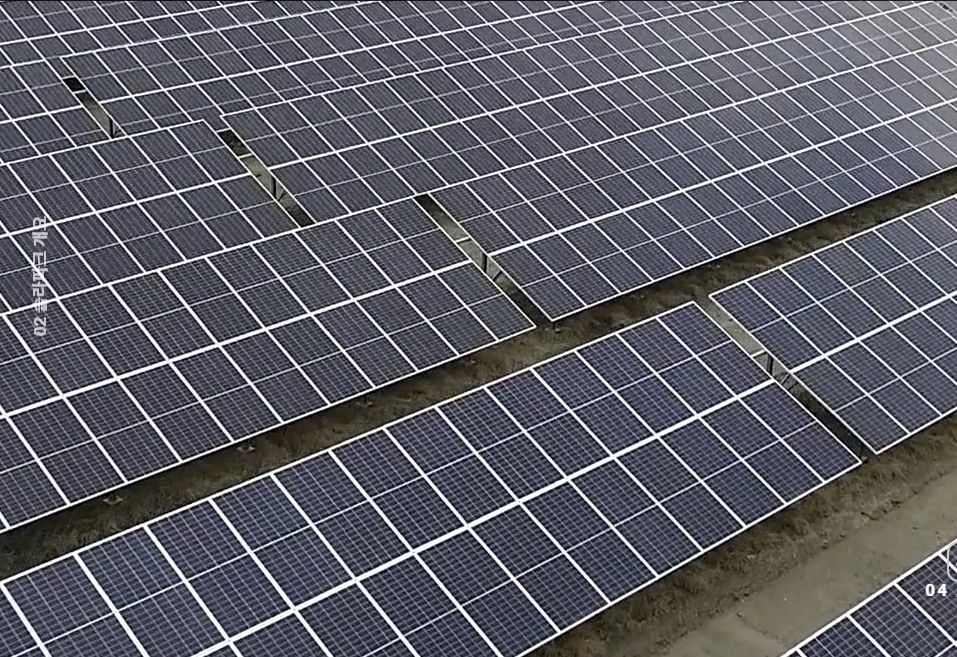 |
Solar modules at Hanyang’s solar power plant (Hanyang) |
Currently, state subsidies are given to electricity per megawatt hour generated by renewable energy sources such as solar power.
When asked whether the plant deserved state subsidies, the Ministry of Trade, Industry and Energy gave an unexpected answer.
“Strictly speaking, the renewable energy subsidy isn’t intended for (the industry) to use parts made in Korea. It’s for the general growth of the industry,” an official from the ministry said.
President Moon Jae-in aims to generate 30-35 percent of the country’s electricity supply using renewable energy by 2040.
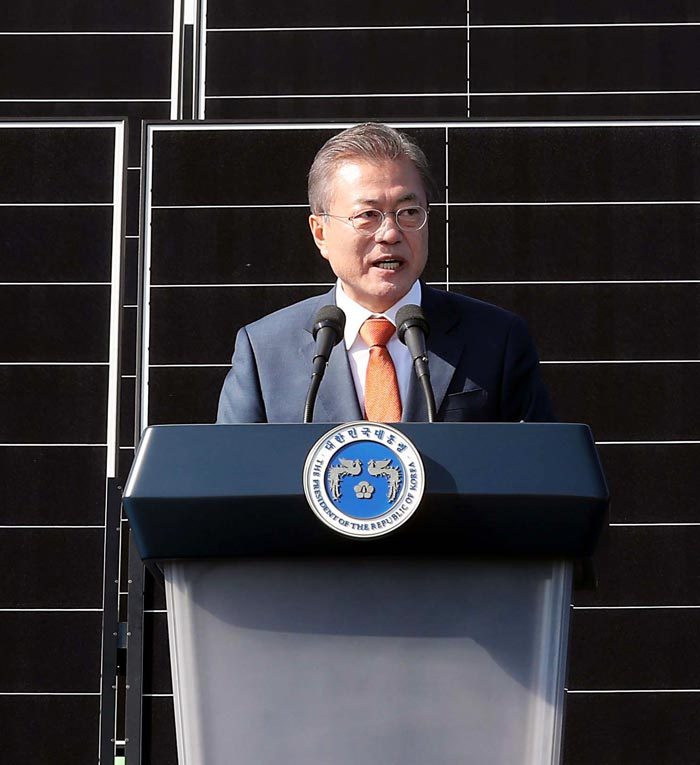 |
President Moon Jae-in gives a speech pledging to make the world’s biggest solar power plant in Saemangeum area in Gunsan, North Jeolla Province, on Oct. 30, 2018. (Yonhap) |
Simply put, Korea’s renewable energy subsidy wasn’t meant for domestic companies in the first place.
The ministry’s comment came as Korea’s solar power industry is being hammered by Chinese solar power businesses, which are using economies of scale -- with cheaper electricity and labor costs.
Last year, the average price of Chinese solar modules and cells stood at $0.27 and $0.14 per watt compared to $0.29 and $0.16 of Korean firms.
The Industry Ministry is fully aware that Korea can’t compete with China due to price competiveness.
In its report released last December, the ministry acknowledged that price competitiveness is the key factor in the global solar power industry.
“Other countries are boosting their support for local (solar power) industries to compete against China,” the report said.
According to Korea Energy Economics Institute, India, the world’s third-largest solar market, offered subsidies to solar power projects provided that at least 50 percent of the supplies of solar modules and cells to projects are locally made from 2013-2017.
Brazil offers interest rates 50 percent cheaper to solar power projects if they meet 60 percent quota of domestic parts. In Turkey, subsidies commensurate with the ratio of domestic parts with minimum quota of 55 percent. If a solar farm in made 60 percent with domestic parts, for example, subsidies are given at 60 percent rate. The US doesn’t even allow imports of foreign solar modules and cells in the first place.
In contrast, protective measures of the Korean government’s renewable energy subsidies are open to all solar projects, even those built entirely using Chinese parts.
As a result, when Korean construction company Hanyang built the country’s largest solar power plant with 98-megawatt capacity, it had no reason to use expensive domestic parts and opted for cheaper Chinese ones.
“Hanyang’s decision to use cheaper Chinese solar cells is a perfectly logical choice as it wants to be profitable,” said Kang Seung-jin, chairman of Electricity Regulatory Commission under the Industry Ministry and energy professor at Korea Polytechnic University.
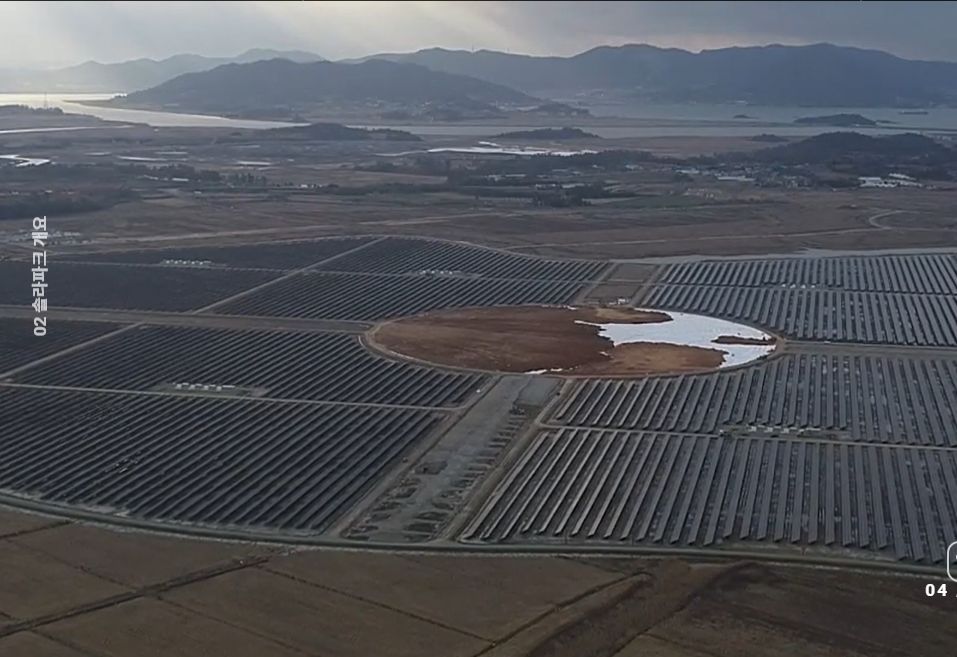 |
Aerial image of Hanyang’s solar power plant (Hanyang) |
However, Hanyang’s solar power plant is not just another private project as it received investments from state-run Korea Southern Power (Kospo).
Kospo and Hanyang co-invested in the project while KB Financial Group participated as a financial advisor. Specific investment amounts haven’t been disclosed.
Over criticism that it invested in a solar power project built with Chinese solar cells, Kospo pointed fingers at Hanyang.
“After realizing that Hanyang was going to build its power plant with Chinese solar modules only, we requested the company to replace some of them with Korea-made modules, though we couldn’t force our opinion on a private company,” a Kospo official said.
“Following the request, Hanyang did increase the ratio of Korea-made modules to 50 percent. However, as it turned out, the modules were mounted with Chinese solar cells.”
Electricity providers equipped with generation facility of 500 megawatt-hours or more are required to generate 7 percent of total electricity with renewable energy sources this year.
Though Kospo’s quota this year stands at 4,039,843 megawatt-hour, it is expected to be met easily as electricity generated by Hanyang’s solar power plant will be counted as Kospo’s.
Kospo has its own goal to generate 30 percent of its total electricity with renewable energy by 2030.
Hanyang, on its part, said it had no choice but to use Chinese parts.
“We did not choose Chinese modules because they were cheaper, but because Korean companies could only handle 20 percent of supplies needed for the construction of the solar power plant. We did our best by raising that figure to 50 percent (by module price),” a Hanyang official said.
Domestic solar power companies in turn refuted Hanyang’s claim, suggesting that the construction company excluded domestic firms from the beginning.
“It takes years of planning to build a solar plant the size of Hanyang’s. Placing orders to domestic companies just before the start of the construction and blaming them for not being able to meet the supplies is a classic way of saying ‘we don’t want to do business with you,’” an industry source said.
“This is a bad example for the Korean solar power industry as the subsidies are being used to buy Chinese modules.”
JinkoSolar, world’s No.1 solar module maker by shipments, has production capacity of solar modules and cells at 16 gigawatts and 10.6 gigawatts, respectively, as of 2019. Hanwha Q Cells, Korea’s leading solar module maker, currently has production capacity of 11.3 gigawatts and 9.3 giagawatts for solar modules and cells.
Meanwhile, the government’s splashy renewable energy push -- albeit its oversight of local parts suppliers -- appears to be working for the Korean energy storage system industry.
ESS is a huge battery, the size of a container, that can store electricity generated by renewable energy sources such as solar power.
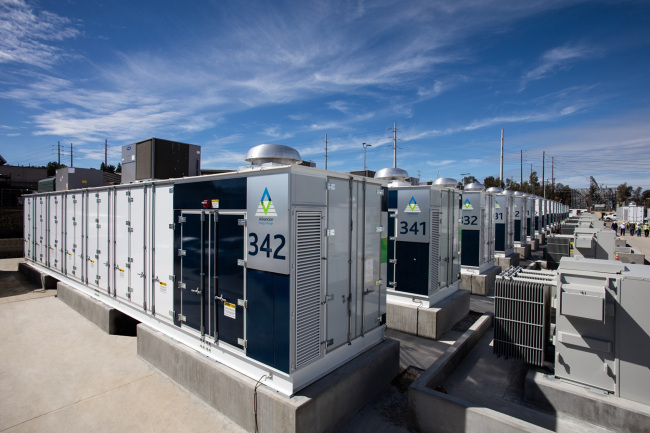 |
Energy storage systems co-built by Samsung SDI in California, US (Samsung SDI) |
“The ESS infrastructure installed at the solar power plant is sourced from Samsung SDI,” a Hanyang official said.
Last September, Hanyang signed a 96 billion won ($80.4 million) supply contract with Hyundai Electric for the design, purchase, installation and the operation of 306-megawatt ESS facilities and purchased from Samsung SDI.
Though the exact price of Samsung SDI’s ESS is confidential, it is estimated at 200,000 won per kilowatt-hour, indicating that the Samsung affiliate sold 61.2 billion won worth of ESS to Hyundai Electric for the 306-megawatt ESS facilities.
“The ESS price stood at about 200,000 won per kilowatt hour, but went up earlier this year as lithium-ion batteries have been supplied primarily for electric vehicles, creating a supply crunch,” a Korea Energy Economics Institute official said.
As criticism toward the government’s subsidy program surged, the Industry Ministry launched a program on Wednesday that incentivizes solar modules that emit less carbon during their entire manufacturing process and when they generate electricity, saying it aims to boost the use of domestic products.
The program is expected to promote the use of domestic solar modules, as they demonstrate higher energy efficiency and power output than Chinese products.
The program will divide solar modules into three groups based on the amount of carbon emissions and apply different subsidy rates. Also, it will give subsidies first to solar modules that have certified their carbon emissions, the ministry explained.
“Solar power, which can generate electricity no more than four hours a day, is a very expensive energy source cost wise. Government is pushing for solar power by force with subsidies, and in such a case, it’s even more inappropriate to use only Chinese parts,” said Son Yang-hoon, a professor of economics at Incheon National University.
“It’s not the right direction to provide policy support to the solar power industry built on Chinese parts at the expense of so many jobs and the ecosystem of the domestic nuclear power industry and coal power industry.”
By Kim Byung-wook (
kbw@heraldcorp.com)











![[Today’s K-pop] Blackpink’s Jennie, Lisa invited to Coachella as solo acts](http://res.heraldm.com/phpwas/restmb_idxmake.php?idx=644&simg=/content/image/2024/11/21/20241121050099_0.jpg)
